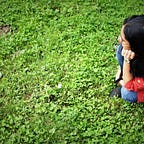In Basel — II
Part I here.
I’ve had a copy of Doctor Copernicus for a few years now, but it needed the push of a trip to a university city in Europe for me to actually get down to reading it. Now, as I traverse the streets of Cracow and Bologna, I think back to Basel and dream of the winding roads of the Old Town, where the university buildings appear unobtrusively, not towering over you, but tucked away behind high walls and gardens.
Wanting to learn more about the city during our trip, we made our way to the Basel Historical Museum on our last morning there. We chose the Barfüsserkirche site, which was originally a Franciscan monastery. The museum here is spread out in the cathedral hall as well as other levels, and houses artefacts ranging from Neanderthal times to the present. Among the most striking displays is the Basel Dance of Death, a series of paintings and verses painted on the wall of a Dominican cemetery. In chilling conversations, various townspeople representing different classes of society plead with Death, represented by a dancing skeleton, to spare them — but Death has other ideas. The 15th century paintings were supposed to have represented the horrors of the plague. The paintings survived the Reformation, but were renovated or restored a few times. However, as people began to get tired of the paintings in the 18th century, the cemetery wall was torn down in 1805. However, a few fragments were saved and housed at the museum. (See history here.)
The museum is home to more than the macabre (or real). A number of chambers display rich tapestries from different periods, many with Biblical themes or fantastical creatures. One of my favourites was a full view of town, depicting buildings with red-tiled roofs, animals, forests, and just people getting on with their lives. Other items take you on a journey into Europe’s scientific past: exhumed skeletons, surgical implements, globes and maps, clocks, and a variety of other fascinating objects. The main hall is primarily devoted to artefacts of religious significance and a whirlwind tour through the ages, with objects from the prehistoric past to a vial of COVID-19 vaccine, plus films describing important Basel events.
Basel is not shy about its pharmaceutical power, but also open about the catastrophe; one of the videos delves into the chemical spill in 1986 after a fire at the Sandoz warehouse and the citizen action that followed to hold the local government accountable, forcing them into action. Talking to our colleague M., we learnt that pharmacy and architecture were among the top industries in Basel. ‘Look at the Roche tower,’ he told us, and indeed, wherever you go, it dominates the skyline (and stands out oddly against the pretty backdrop of gently rolling hills and river-carved town). It is now the tallest building in Switzerland, which seems strict about limiting skyscrapers.
Industry aside, there are still some markers of the trade guilds that thrived some centuries ago in Basel. We noticed a couple of signs at a restaurant, beneath which a group of men wearing hats in the sign colours nursed their beers. M. told us that it meant that members of this guild patronised the restaurant. The guilds are mostly hereditary now.
***
Basel is thankfully still in my head a month later, notwithstanding attempts at disruption from different people and places. Books play a huge part in keeping the memories alive. Browsing at a bookstore at the Zürich train station, I ran into a couple after my own heart. Dressed elegantly with a whiff of an early drink about them, very European in countenance, they stopped by the English section; the man said he saw only popular books. ‘I don’t want to read them because everyone else is reading them,’ he said, confident and sheepish at once. I shamelessly eavesdrop on conversations in bookshops (or rather everywhere, for where else is a writer supposed to find their material except in overheard gossip?), and I told him to stay away from the back of the shop, which was devoted to bestsellers. As we bonded over our snobbery, I asked the couple if they could recommend local writers in translation. The man gave me a name. Because I am useless at understanding German names not said in an English accent, he kindly pulled out his phone and typed out the name for me. He also gave me the name of a book. Incidentally, the author turned out to be one my German-speaking Austrian friend H. had also recommended, so I went on a hunt upon returning to India.
Thus it was that I read the wonderful book The Judge and his Hangman, a crime novel by Friedrich Dürrenmatt that raises questions of morality while unravelling a police-and-criminal chase. I am on the hunt for more of his work now, as also more Swiss writing in English. H. reminded me that his own recommendations were only for authors writing in German, which gave me a reality check; funny how I think that I’ve been exposed to a country, when I’ve barely scratched the surface of one city and had no interaction with the French or Italian or Romansh speaking parts.
Help me keep memories of Basel (or Switzerland) alive in my heart and head, then. Tell me of books from there, while I return to some Mark Twain to prepare for the next installment on Luzern and Mt Rigi (the Alps at last!).
